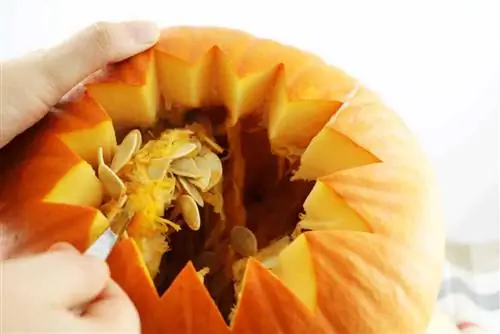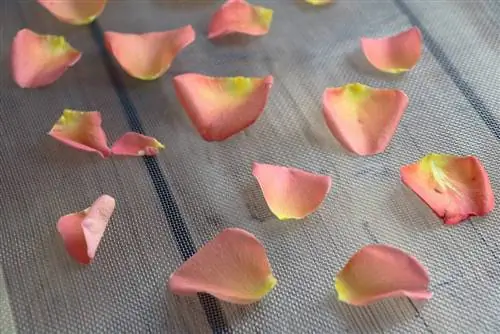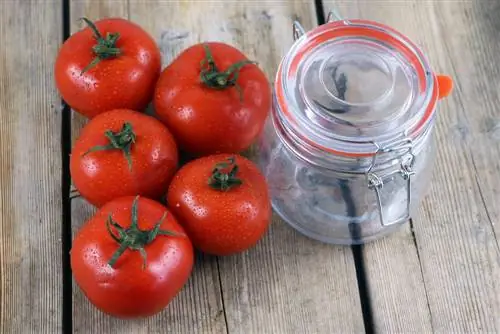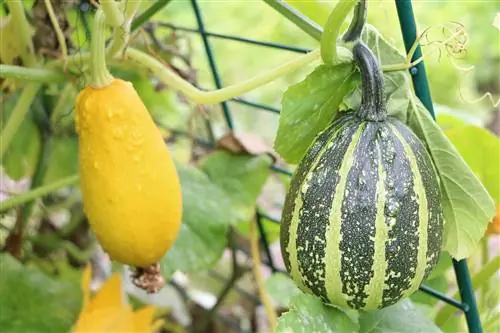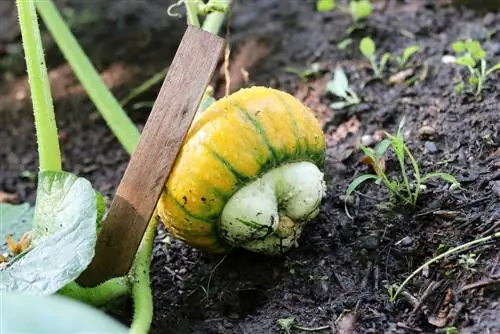- Author admin [email protected].
- Public 2023-12-17 03:39.
- Last modified 2025-01-24 12:45.
It's understandable that the pumpkin doesn't last forever. After all, it is a fruit vegetable that consists of a high percentage (up to 90%) of water and not only loses it over time, but also comes into contact with bacteria that decompose it or cause mold. Dehydration, mold and bacteria are the main reasons for the decay of a pumpkin. Hollowed out Halloween pumpkins are particularly at risk because, firstly, they contain a lot of pulp and therefore water and secondly, the pumpkin is injured. This means that more microorganisms can penetrate.
Various methods of preservation
Some methods of preserving a pumpkin are based on removing the water. Others do the exact opposite. Here we try to keep the pumpkin as fresh as possible and to supply it with water. Above all, it is important to avoid bacteria as best as possible or to kill them so that the deterioration does not accelerate even further. Halloween pumpkins must always be hollowed out first before preserving. Different methods are usually used to preserve a hollowed pumpkin and ornamental pumpkins. Here is an overview of varieties of potential Halloween pumpkins:
- Jack O`lantern (lantern pumpkin)
- Little Lantern
- Neon F1
- Sweet Jack
- Aspen Pumpkin
- Autumn King
- Baby Bear
Example varieties for ornamental pumpkins:
- Shenot Crowns
- Gourd Verruquese
- Mini Ball
- Autumn Wing
The perfect harvest time
Pressure points, injuries or cuts promote the penetration of bacteria and thus rot and mold. Therefore, only pumpkins that have an absolutely undamaged shell should be used. In addition, the correct harvest time is also extremely important for the shelf life of a pumpkin. The size and color of the fruit alone say nothing about the degree of ripeness. Signs of a ripe pumpkin:
- Stem woody
- firm, hard shell
- must sound hollow when knocked
Storage
If the pumpkin is not to be used immediately, it should not be stored anywhere and in any way. Good storage conditions:
- Wooden box (air-permeable)
- line with Styrofoam
- Temperature: 15-20 °C
Hollow out the Halloween pumpkin properly
Before a pumpkin is hollowed out, its shell must first be washed thoroughly. There are always a lot of microorganisms on the outer skin that would otherwise penetrate the inside of the pumpkin.
- wash with lukewarm soapy water
- rinse with clean water
- dry off
A Halloween pumpkin must be hollowed out very carefully and completely. All sticky components are very susceptible to mold.
- sharp, very clean tool
- smooth cuts without fringes and unnecessary corners
Tip:
How thick the remaining pulp is has no significant influence on the shelf life. If something too much has been cut off, it's not a problem.
Slow down mold formation on hollowed out pumpkins

Various means are possible to kill microorganisms such as bacteria. Since the agents have a corrosive effect and pose a risk to skin and eyes, you should always work with gloves and possibly protective goggles. If soaking for a longer period of time, the bucket must be placed in a child and pet safe manner to avoid accidents. Bacterial killing agents:
- Vinegar
- Citric Acid
- bleach
Acid or bleach is always diluted with water and the hollowed out pumpkin is placed in it with the opening facing down.
- Bucket or larger container
- Bleach: 15 ml per liter of water
- Lemon juice: one part water plus one part citric acid
- cold water
- Soak for at least an hour or overnight
- dry well
- Rub cut edges with Vaseline (sealing)
Tip:
Special pumpkin sprays usually contain a bacteria-killing component and an oil or wax.
Maintain moisture
- with varnish or hairspray: Once the pumpkin has been hollowed out cleanly and dried well, it is sprayed inside and out with hairspray or varnish. The varnish seals the surface and prevents the pumpkin from losing liquid. It should be sprayed every now and then. Unfortunately, this method does not protect against mold formation.
- with Vaseline: A good home remedy to make a Halloween pumpkin last a little longer is Vaseline. After hollowing out, simply dry it well with kitchen roll and apply a thick layer of petroleum jelly. Lasts two to three weeks.
- with floor wax or beeswax: A wax cover protects the sensitive pumpkin from water loss and pressure points. In addition, floor polish or beeswax gives it a natural shine.
By the way:
If the Halloween pumpkin is shriveled up - but not moldy - a rejuvenation treatment can help the scary face: soak it in a bucket of cold water overnight!
Drying ornamental pumpkins
Rapid removal of water, for example at higher temperatures in the oven or on the heater, means that the pumpkin loses its water, but during this process it also shrinks significantly and becomes unsightly and wrinkled. The safest way to preserve a pumpkin is to dry it slowly. And for months. Not a really practical way to quickly preserve a Halloween pumpkin. Drying is particularly ideal for ornamental pumpkins. An ornamental pumpkin contains less pulp and therefore water, making it easier to dry.
- harvest ripe pumpkin when the leaves on the tendrils have already dried out slightly
- cut with a smooth cut
- IMPORTANT: Leave 3-5 cm of stem standing
- helps drain the water
- Wash pumpkin with lukewarm soapy water
- rinse with clean water
- lay out to dry in the garage, house or shed
- place on higher surface
- Air must also come to the pumpkin from below (boards with gaps)
- Make sure there is good air circulation
- turn carefully every two to three weeks
Depending on the size of the pumpkin, it can take between six and twelve months for the pumpkin to dry. A good indication that it is drying is that a rattling sound can be heard when shaking (through the seeds) and the pumpkin is very light. In some cases, the cores may be stuck inside and therefore do not make any noise.
Alternatively, the decorative pumpkin can also be hung up to dry. To do this, wrap the pumpkin around the stem with a string and hang it in a well-ventilated place. To better drain the moisture from the inside, use a clean nail to poke three to four holes in the underside. Inside buildings, it is recommended to place a newspaper or a flower coaster underneath to avoid stains. After drying, wash the pumpkins again with soapy water. If the shell has become wrinkled or stained, the outer layer can be carefully scraped off with a clean, sharp knife.
Conclusion
It is best to first hollow out a Halloween pumpkin and then dip it into a bacteria-killing solution. So that it retains water better, applying cream with petroleum jelly or beeswax has proven to be effective. Decorative pumpkins can be hung up or dried on a breathable surface with good air circulation. These methods keep the scary face of a hollowed pumpkin fresh for about two to three weeks, ornamental pumpkins sometimes stay beautiful for up to several years if they have been dried well.
What you should know about hollowed out pumpkins soon
Custom of Pumpkin Carving
- The custom of carving a pumpkin on Halloween originally comes from Ireland.
- In his day, however, turnips were carved to drive away evil spirits.
- When the custom spread to America, pumpkins were used instead of turnips.
- These are much better for carving due to their texture and size.
- Since then, pumpkins have been used for Halloween carving to this day.
Use pumpkin
- The pulp of the pumpkin is extremely he althy and tasty.
- Therefore, the hollowed out fruit pulp that is produced during pumpkin carving is the basis for many delicious dishes: pumpkin soup, jacket potato and pumpkin salad, chili con pumpkin, meat and pumpkin stew, pumpkin bread, pumpkin pan with herbs or pumpkin -Ice cream
- The pulp can also easily be grilled, roasted or pickled.
- Some pumpkin varieties have oily seeds from which the popular pumpkin seed oil is obtained.

